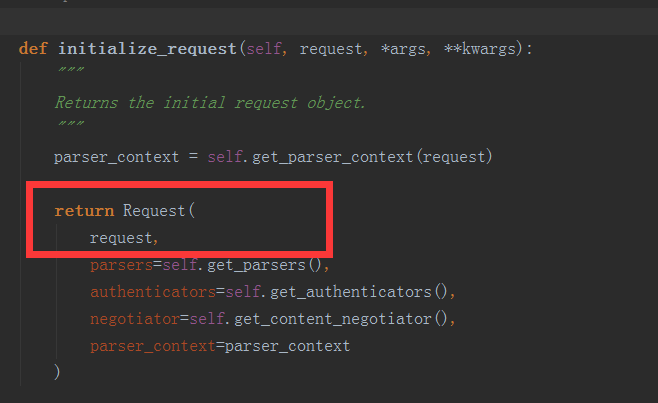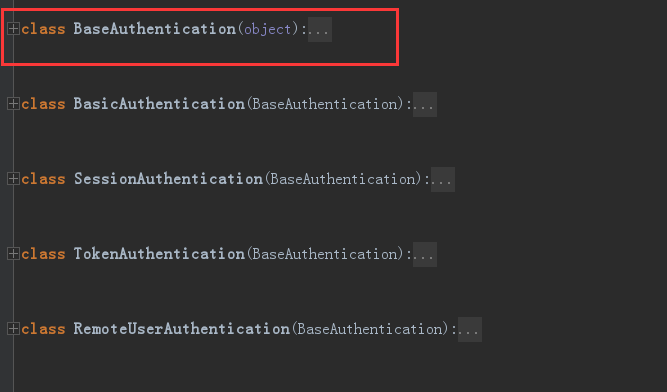Django rest framework 源码分析 (1)----认证
一、基础
django 2.0官方文档
https://docs.djangoproject.com/en/2.0/
安装
pip3 install djangorestframework
假如我们想实现用户必须是登陆后才能访问的需求,利用restframework该如何的去实现,具体的源码流程又是怎么样的呢
为了有一个清晰的认识,先直接上代码,有一个清晰的认识,在剖析源码流程
首先先创建一个应用
python manage.py startapp app01
在应用 app01.views.py 下 的视图函数的代码如下
from rest_framework.views import APIViewfrom rest_framework import exceptions
from rest_framework.request import Request class MyAuthentication(object):
def authenticate(self,request):
token = request._request.GET.get('token')
# 获取用户名和密码,去数据校验
if not token:
raise exceptions.AuthenticationFailed('用户认证失败')
return ("dog",None) def authenticate_header(self,val):
pass class DogView(APIView):
authentication_classes = [MyAuthentication,] def get(self,request,*args,**kwargs):
print(request)
print(request.user)
self.dispatch
ret = {
'code':1000,
'msg':'xxx'
}
return HttpResponse(json.dumps(ret),status=201)
在项目的根目录下的urls.py 中添加路由的代码如下:
from app01 import views urlpatterns = [
url(r'^dog/', views.DogView.as_view()),
]
如果想实现必须是登陆后才能进行请求的话,只需重写父类中的 authenticate (进行一些逻辑认证)和 authenticate_header 就能达到认证的效果
启动项目,在浏览器中输入
http://127.0.0.1:8000/dog/?token=123
‘携带token返回的结果如下
{"code": 1000, "msg": "xxx"}
没有携带token返回的结果如下
http://127.0.0.1:8000/dog

源码分析
那么上面的源码内部又是如何是现代的呢
源码流程图

源码入口先从 dispatch 开始入口
def dispatch(self, request, *args, **kwargs):
"""
`.dispatch()` is pretty much the same as Django's regular dispatch,
but with extra hooks for startup, finalize, and exception handling.
"""
self.args = args
self.kwargs = kwargs
# 对原生的request进行封装
request = self.initialize_request(request, *args, **kwargs)
self.request = request
self.headers = self.default_response_headers # deprecate? try:
self.initial(request, *args, **kwargs) # Get the appropriate handler method
if request.method.lower() in self.http_method_names:
handler = getattr(self, request.method.lower(),
self.http_method_not_allowed)
else:
handler = self.http_method_not_allowed response = handler(request, *args, **kwargs) except Exception as exc:
response = self.handle_exception(exc) self.response = self.finalize_response(request, response, *args, **kwargs)
return self.response
可以看出上面的代码中对原生的request进行了封装
request = self.initialize_request(request, *args, **kwargs)
self.request = request
那么它内部做了些什么呢 ,追踪 self.initialize_request 代码如下:
def initialize_request(self, request, *args, **kwargs):
"""
Returns the initial request object.
"""
parser_context = self.get_parser_context(request) return Request(
request,
parsers=self.get_parsers(),
authenticators=self.get_authenticators(),
negotiator=self.get_content_negotiator(),
parser_context=parser_context
)
我们可以看到 authenticators=self.get_authenticators() 这个貌似和认证有关系,追踪get_authenticators 代码如下:
def get_authenticators(self):
"""
Instantiates and returns the list of authenticators that this view can use.
"""
return [auth() for auth in self.authentication_classes]
通过上面的代码我们可以看到 其返回的是通过列表生成式返回的一个实例化对象 那么它是通过什么生成这个对象的呢,下面我们来继续追踪 self.authentication_classes 其代码如下所示:
class APIView(View):
# The following policies may be set at either globally, or per-view.
renderer_classes = api_settings.DEFAULT_RENDERER_CLASSES
parser_classes = api_settings.DEFAULT_PARSER_CLASSES
authentication_classes = api_settings.DEFAULT_AUTHENTICATION_CLASSES
到这里我们发现它是通过读取应用的配置文件,到这里神秘的面纱已经开始解开了,加入我们自己写的类如果自己的内部有 authentication_classes 这个属性,并且其也是一个可迭代的对象,那么根据面向对象的属性,就会执行我们
自己的self.authentication_classes ,而不是默认到配置文件中去找。
对request的总结:
上面对原生的request对象进行了一些封装和获得了认证的实例话对象的列表
执行认证
继续追踪 dispatch 中的 self.initial 代码如下:
def initial(self, request, *args, **kwargs):
"""
Runs anything that needs to occur prior to calling the method handler.
"""
self.format_kwarg = self.get_format_suffix(**kwargs) # Perform content negotiation and store the accepted info on the request
neg = self.perform_content_negotiation(request)
request.accepted_renderer, request.accepted_media_type = neg # Determine the API version, if versioning is in use.
version, scheme = self.determine_version(request, *args, **kwargs)
request.version, request.versioning_scheme = version, scheme # Ensure that the incoming request is permitted
self.perform_authentication(request)
self.check_permissions(request)
self.check_throttles(request)
根据英文的意思看以看到 self.perform_authentication 的意思是执行认证的意思,让我们追踪其内部的代码如下:
def perform_authentication(self, request):
"""
Perform authentication on the incoming request. Note that if you override this and simply 'pass', then authentication
will instead be performed lazily, the first time either
`request.user` or `request.auth` is accessed.
"""
request.user
看到其调用的是对原始request封装后的user ,追踪其 内部的user发现其是一个实例属性,代码如下所示

点进去可以看到Request有个user方法
@property
def user(self):
"""
Returns the user associated with the current request, as authenticated
by the authentication classes provided to the request.
"""
if not hasattr(self, '_user'):
with wrap_attributeerrors():
self._authenticate()# 获取认证对象进行一步步的认证
return self._user
让我们进行追踪 self._authenticate() 代码如下:
def _authenticate(self):
"""
Attempt to authenticate the request using each authentication instance
in turn.
"""
for authenticator in self.authenticators:
try:
user_auth_tuple = authenticator.authenticate(self)
except exceptions.APIException:
self._not_authenticated()
raise if user_auth_tuple is not None:
self._authenticator = authenticator
self.user, self.auth = user_auth_tuple
return self._not_authenticated()
执行认证类的authenticate方法
这里分三种情况
1.如果authenticate方法抛出异常,self._not_authenticated()执行后在抛出异常-----就是认证没通过
2.有返回值,必须是元组:(request.user,request.auth)
3.返回None,表示当前认证不处理,等下一个认证来处理
返回值就是例子中的:
token_obj.user-->>request.user
token_obj-->>request.auth
通过认证自定义的authenticated没有返回值,就执行self._not_authenticated(),相当于匿名用户,
def _not_authenticated(self):
"""
Set authenticator, user & authtoken representing an unauthenticated request. Defaults are None, AnonymousUser & None.
"""
self._authenticator = None if api_settings.UNAUTHENTICATED_USER:
self.user = api_settings.UNAUTHENTICATED_USER() #AnonymousUser匿名用户
else:
self.user = None if api_settings.UNAUTHENTICATED_TOKEN:
self.auth = api_settings.UNAUTHENTICATED_TOKEN() #None
else:
self.auth = None
因为authenticate方法我们自己重写了,所以当执行authenticate()的时候就是执行我们自己写的认证
父类中的authenticate方法
def authenticate(self, request):
return (self.force_user, self.force_token)
我们自己写的
def authenticate(self,request):
token = request._request.GET.get('token')
# 获取用户名和密码,去数据校验
if not token:
raise exceptions.AuthenticationFailed('用户认证失败')
return ("dog",None)
所以到这里我们就搞懂了我们在做用户认证的时候为什么需要重其authenticate的方法了
以上的是我们自己定义的 authentication_classes 它会去我们的类属性中使用我们自己的,只需在需要认证接口的中设置类属性 authentication_classes = [ 认证的逻辑函数 ]
全局认证
假如我们进行全局认证的话,可以在配置文件中设置,通过继承父类的方式来实现,简单的说就是 类属性 authentication_classes 自己不定义使用父类的,看以下的代码:
class APIView(View):
# The following policies may be set at either globally, or per-view.
renderer_classes = api_settings.DEFAULT_RENDERER_CLASSES
parser_classes = api_settings.DEFAULT_PARSER_CLASSES
authentication_classes = api_settings.DEFAULT_AUTHENTICATION_CLASSES
在以上的代码中我们可以看到authentication_classes = = api_settings.DEFAULT_AUTHENTICATION_CLASSES 我们可以追踪看到代码如下:
def reload_api_settings(*args, **kwargs):
setting = kwargs['setting']
if setting == 'REST_FRAMEWORK':
api_settings.reload() setting_changed.connect(reload_api_settings)
这是它会去配置文件中读取 REST_FRAMEWORK ,这时后我们可以在配置文件中添加这个配置,里面的键是 DEFAULT_PARSER_CLASSES 值是认证函数的路径
REST_FRAMEWORK = {
# 全局使用的认证类
"DEFAULT_AUTHENTICATION_CLASSES":['api.utils.auth.Authtication', ],
}
我们根据上述配置的路径,在应用api建立以下文件 utils/auth.py 代码如下:
class Authtication(BaseAuthentication):
def authenticate(self,request):
token = request._request.GET.get('token')
token_obj = models.UserToken.objects.filter(token=token).first()
if not token_obj:
raise exceptions.AuthenticationFailed('用户认证失败')
# 在rest framework内部会将整个两个字段赋值给request,以供后续操作使用
return (token_obj.user, token_obj) def authenticate_header(self, request):
pass
这时后所有的接口,必须经过认证后才能访问,但是有的接口是不需要认证的,比如登陆的时候这时,我们可以在登陆的接口中不走父类(apiview) 的认证使用我们自己 的,只需定义定义类属性authentication_classes = [ ] 即可
class AuthView(APIView):
"""
用于用户登录认证
"""
authentication_classes = [] def post(self,request,*args,**kwargs):
pass
关于匿名用户登陆的设置
有些时候用户是在没有登陆的时候,访问我们的接口,这时候我们称之为匿名的用户,我们可以对其进行简单的设置
def _authenticate(self):
"""
Attempt to authenticate the request using each authentication instance
in turn.
"""
for authenticator in self.authenticators:
try:
user_auth_tuple = authenticator.authenticate(self)
except exceptions.APIException:
self._not_authenticated()
raise if user_auth_tuple is not None:
self._authenticator = authenticator
self.user, self.auth = user_auth_tuple
return self._not_authenticated() def _not_authenticated(self):
"""
Set authenticator, user & authtoken representing an unauthenticated request. Defaults are None, AnonymousUser & None.
"""
self._authenticator = None if api_settings.UNAUTHENTICATED_USER:
self.user = api_settings.UNAUTHENTICATED_USER()
else:
self.user = None if api_settings.UNAUTHENTICATED_TOKEN:
self.auth = api_settings.UNAUTHENTICATED_TOKEN()
else:
self.auth = None
在上面的源码中我们可以看到 匿名用户默认的request.user=AnonymousUser, request.auth = None ,我们来写一个接口来简单的认证以下
class UserInfoView(APIView):
authentication_classes = []
def get(self,request,*args,**kwargs):
print(request.user)
print(request.auth )
return HttpResponse('用户信息')
为其 配置url
url(r'^api/v1/info/$', views.UserInfoView.as_view()),
在浏览器中输入
http://127.0.0.1:8000/api/v1/info/
测试的结果如下:

源码中的user 和token 的设置如下:
if api_settings.UNAUTHENTICATED_USER:
self.user = api_settings.UNAUTHENTICATED_USER()
else:
self.user = None if api_settings.UNAUTHENTICATED_TOKEN:
self.auth = api_settings.UNAUTHENTICATED_TOKEN()
我们可以看到 对user 和 token 的设置,我们可以定义一个函数,所以我们可以这样设置,
REST_FRAMEWORK = {
# 全局使用的认证类
"DEFAULT_AUTHENTICATION_CLASSES":['api.utils.auth.FirstAuthtication','api.utils.auth.Authtication', ],
# "UNAUTHENTICATED_USER":lambda :"匿名用户",
"UNAUTHENTICATED_USER": None
"UNAUTHENTICATED_TOKEN":None,
}
测试的结果如下:

drf的内置认证类
rest_framework里面内置了一些认证,我们自己写的认证类最好都要继承内置认证类 "BaseAuthentication"
from rest_framework.authentication import BasicAuthentication
BaseAuthentication源码:
class BaseAuthentication(object):
"""
All authentication classes should extend BaseAuthentication.
""" def authenticate(self, request):
"""
Authenticate the request and return a two-tuple of (user, token).
"""
#内置的认证类,authenticate方法,如果不自己写,默认则抛出异常
raise NotImplementedError(".authenticate() must be overridden.") def authenticate_header(self, request):
"""
Return a string to be used as the value of the `WWW-Authenticate`
header in a `401 Unauthenticated` response, or `None` if the
authentication scheme should return `403 Permission Denied` responses.
"""
#authenticate_header方法,作用是当认证失败的时候,返回的响应头
pass
其它内置认证类
rest_framework里面还内置了其它认证类,我们主要用到的就是BaseAuthentication,剩下的很少用到

总结
自己写认证类方法梳理
(1)创建认证类
- 继承BaseAuthentication --->>1.重写authenticate方法;2.authenticate_header方法直接写pass就可以(这个方法必须写)
(2)authenticate()返回值(三种)
- None ----->>>当前认证不管,等下一个认证来执行
- raise exceptions.AuthenticationFailed('用户认证失败') # from rest_framework import exceptions
- 有返回值元祖形式:(元素1,元素2) #元素1复制给request.user; 元素2复制给request.auth
(3)局部使用
- authentication_classes = [BaseAuthentication,]
(4)全局使用
#设置全局认证
REST_FRAMEWORK = {
"DEFAULT_AUTHENTICATION_CLASSES":['API.utils.auth.Authentication',]
}
Django rest framework 源码分析 (1)----认证的更多相关文章
- Django rest framework源码分析(一) 认证
一.基础 最近正好有机会去写一些可视化的东西,就想着前后端分离,想使用django rest framework写一些,顺便复习一下django rest framework的知识,只是顺便哦,好吧. ...
- Django rest framework源码分析(1)----认证
目录 Django rest framework(1)----认证 Django rest framework(2)----权限 Django rest framework(3)----节流 Djan ...
- Django rest framework源码分析(3)----节流
目录 Django rest framework(1)----认证 Django rest framework(2)----权限 Django rest framework(3)----节流 Djan ...
- Django Rest Framework源码剖析(一)-----认证
一.简介 Django REST Framework(简称DRF),是一个用于构建Web API的强大且灵活的工具包. 先说说REST:REST是一种Web API设计标准,是目前比较成熟的一套互联网 ...
- Django rest framework源码分析(4)----版本
版本 新建一个工程Myproject和一个app名为api (1)api/models.py from django.db import models class UserInfo(models.Mo ...
- Django rest framework源码分析(2)----权限
目录 Django rest framework(1)----认证 Django rest framework(2)----权限 Django rest framework(3)----节流 Djan ...
- Django Rest Framework源码剖析(八)-----视图与路由
一.简介 django rest framework 给我们带来了很多组件,除了认证.权限.序列化...其中一个重要组件就是视图,一般视图是和路由配合使用,这种方式给我们提供了更灵活的使用方法,对于使 ...
- 3---Django rest framework源码分析(3)----节流
Django rest framework源码分析(3)----节流 目录 添加节流 自定义节流的方法 限制60s内只能访问3次 (1)API文件夹下面新建throttle.py,代码如下: # u ...
- Django之REST framework源码分析
前言: Django REST framework,是1个基于Django搭建 REST风格API的框架: 1.什么是API呢? API就是访问即可获取数据的url地址,下面是一个最简单的 Djang ...
随机推荐
- mac终端调用编辑器打开文件
1.调用atom编辑器,前提是编辑器打开, cd+filename 2 .VScode里面: 调用终端:ctrl + `(esc健下面那个) 安装:shift + command+ p 安装如下插件 ...
- 第44章 添加新协议 - Identity Server 4 中文文档(v1.0.0)
除了对OpenID Connect和OAuth 2.0的内置支持之外,IdentityServer4还允许添加对其他协议的支持. 您可以将这些附加协议端点添加为中间件或使用例如MVC控制器.在这两种情 ...
- WPF 中图片的加载 ,使用统一资源标识符 (URI)
在wpf中,设置图片路径有2种方法: 1.xaml文件中,指定路径 <Button Name=" HorizontalAlignment="Right" Verti ...
- java数组及数组的插入,删除,冒泡算法
1.数组的定义 数组为相同类型的若干个数据,在一个数组里面,不能存放多种不同类型的数据,其中每个数据为该数组的一个元素,可以通过下标对改元素进行访问. 1.1 数组的特点 (1)数组被创建后,长度就已 ...
- Activiti(二) springBoot2集成activiti,集成activiti在线设计器
摘要 本篇随笔主要记录springBoot2集成activiti流程引擎,并且嵌入activiti的在线设计器,可以通过浏览器直接编辑出我们需要的流程,不需要通过eclipse或者IDEA的actiB ...
- vue 页面跳转的两种方式
1,标签跳转 <router-link to='two'><button>点我到第二个页面</button></router-link> 2,点 ...
- java程序员学C#
因为工作需要,我要学习C#,其实我觉得不错,我喜欢了解更多的语言,因为这对我今后的发展很有帮助,毕竟技多不压身,下面是我今天学习后总结C#的基本语法: 我曾经学过C,而且又是java程序员,所以对我来 ...
- ArcFace虹软与Dlib人脸识别对比
我司最近要做和人脸识别相关的产品,原来使用的是其他的在线平台,识别率和识别速度很满意,但是随着量起来的话,成本也是越来越不能接受(目前该功能我们是免费给用户使用的),而且一旦我们的设备掉线了就无法使用 ...
- 设计模式系列之单例模式(Singleton Pattern)
单例模式(Singleton Pattern)是 Java 中最简单的设计模式之一.这种类型的设计模式属于创建型模式,它提供了一种创建对象的最佳方式.这种模式涉及到一个单一的类,该类负责创建自己的对象 ...
- 设计模式系列之过滤器模式(Chriteria Pattern)
过滤器模式(Filter Pattern)或标准模式(Criteria Pattern)是一种设计模式,这种模式允许开发人员使用不同的标准来过滤一组对象,通过逻辑运算以解耦的方式把它们连接起来.这种类 ...
